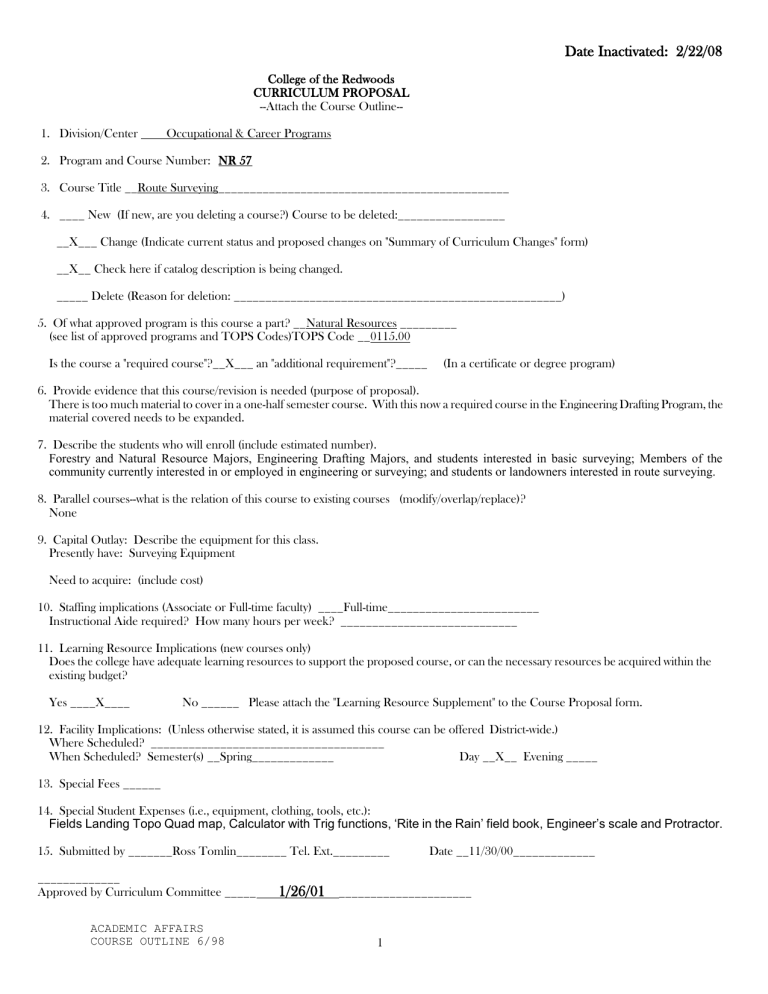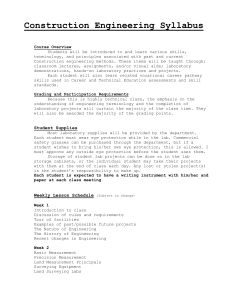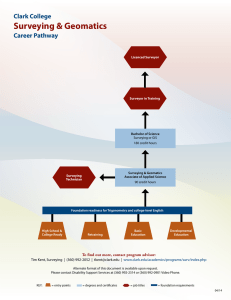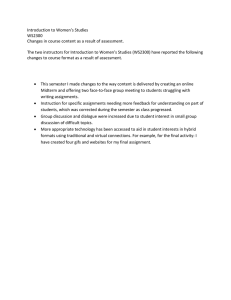Date Inactivated: 2/22/08

Date Inactivated: 2/22/08
College of the Redwoods
CURRICULUM PROPOSAL
--Attach the Course Outline--
1. Division/Center Occupational & Career Programs
2. Program and Course Number: NR 57
3. Course Title __Route Surveying______________________________________________
4. ____ New (If new, are you deleting a course?) Course to be deleted:_________________
__X___ Change (Indicate current status and proposed changes on "Summary of Curriculum Changes" form)
__X__ Check here if catalog description is being changed.
_____ Delete (Reason for deletion: ____________________________________________________)
5. Of what approved program is this course a part? __Natural Resources _________
(see list of approved programs and TOPS Codes)TOPS Code __0115.00
Is the course a "required course"?__X___ an "additional requirement"?_____ (In a certificate or degree program)
6. Provide evidence that this course/revision is needed (purpose of proposal).
There is too much material to cover in a one-half semester course. With this now a required course in the Engineering Drafting Program, the material covered needs to be expanded.
7. Describe the students who will enroll (include estimated number).
Forestry and Natural Resource Majors, Engineering Drafting Majors, and students interested in basic surveying; Members of the community currently interested in or employed in engineering or surveying; and students or landowners interested in route surveying.
8. Parallel courses--what is the relation of this course to existing courses (modify/overlap/replace)?
None
9. Capital Outlay: Describe the equipment for this class.
Presently have: Surveying Equipment
Need to acquire: (include cost)
10. Staffing implications (Associate or Full-time faculty) ____Full-time________________________
Instructional Aide required? How many hours per week? ____________________________
11. Learning Resource Implications (new courses only)
Does the college have adequate learning resources to support the proposed course, or can the necessary resources be acquired within the existing budget?
Yes ____X____ No ______ Please attach the "Learning Resource Supplement" to the Course Proposal form.
12. Facility Implications: (Unless otherwise stated, it is assumed this course can be offered District-wide.)
Where Scheduled? _____________________________________
When Scheduled? Semester(s) __Spring_____________ Day __X__ Evening _____
13. Special Fees ______
14. Special Student Expenses (i.e., equipment, clothing, tools, etc.):
Fields Landing Topo Quad map, Calculator with Trig functions, ‘Rite in the Rain’ field book, Engineer’s scale and Protractor.
15. Submitted by _______Ross Tomlin________ Tel. Ext._________ Date __11/30/00_____________
_____________
Approved by Curriculum Committee _____
1/26/01
_____________________
ACADEMIC AFFAIRS
COURSE OUTLINE 6/98
1
FEATURES
SUMMARY OF CURRICULUM CHANGES
OLD NEW
Grading Standard
Prerequisites
Corequisites
Recommended
Preparation
Repeatability -
Maximum Enrollments
Repeatability -
Maximum Units
Maximum Class Size
TLUs
Lectures Hours
Lab Hours
Method of Instruction
Units
Other
None
FOR 52
3.0
18 total
27 total
1.5
FOR 57
NR 52
None
4.5
1 per week for semester
3 per week for semester
2.0
NR 57
If any of the listed features have been modified in the new proposal, indicate the "old" (current) information and proposed changes.
ACADEMIC AFFAIRS
COURSE OUTLINE 6/98
2
College of the Redwoods
COURSE OUTLINE
PROGRAM AND COURSE NUMBER: __NR 57__________________________
FORMER NUMBER (If previously offered) ____FOR 57__________
COURSE TITLE : Route Surveying
I. CATALOG AND OUTLINE
DATE __11/30/00________________
1. CATALOG DESCRIPTION:
The basic concepts and techniques of locating, laying out, designing, and preparing roads and trails for construction. Road locations will be flagged to specific grade requirements, and students will collect data on directions, elevations, and cross sections. That data will then be used to design the road, calculating cut and fill volumes required at each station, along with vertical and horizontal curve locations. The designed road will then be staked for construction. Culvert locations and water movement over the road will be considered.
NOTE: Field trips are required. The College does not provide transportation.
2. COURSE OUTLINE:
Introduction to course and Route Surveying
Forest Road location and reconnaissance
% of Classroom Hours Spent on Each Topic
5%
10%
Surveying road using traverse and profile techniques
Surveying the road – cross sections
Horizontal curves
Road design process
Slope Staking the road
Culvert placement and water movement
Total
15%
6%
12%
30%
12%
10%
___
100%
II. PREREQUISITES
Prerequisite?
Corequisite?
No _________
No ____X___
Yes ___NR 52___________
(course)
Yes _____________________
(course)
Recommended Preparation? No ____X___
Rationale for Prerequisite, Corequisite, Recommended Preparation:
Yes _____________________
(course)
NR 57 builds on the foundation and skills obtained in NR 52 – Introduction to Surveying. These skills are essential to succeed in this course.___________________________________________________________________________________________________
ACADEMIC AFFAIRS
COURSE OUTLINE 6/98
3
PROGRAM AND COURSE NUMBER_____NR 57
III. OUTCOMES AND ASSESSMENTS
1. COURSE OUTCOMES/OBJECTIVES:
List the primary instructional objectives of the class. Formulate some of them in terms of specific measurable student accomplishments, e.g., specific knowledge and/or skills to be attained as a result of completing this course. For degree-applicable courses, include objectives in the area of "critical thinking." Upon successful completion of this course, the students will be able to:
1.
Understand and successfully operate the basic instruments and tools used in route surveying and engineering
2.
Demonstrate knowledge of drafting techniques and forest mapping (roads, contour lines, topography, timber types, ownership, rectangular land survey, charts and graphs).
3.
Use survey equipment and tools to collect both horizontal and vertical measurements on elevations, directions, and cross-sections.
4.
Successfully layout and design roads on paper to meet grade and environmental requirements and calculate the amount of earthwork needed to build the road.
5.
Slope stake the road after the design process to indicate to heavy equipment operators where the cuts and fills will be placed.
6.
Properly locate water diversion structures and understand the effect of water movement over a road.
2. COLLEGE LEVEL CRITICAL THINKING TASKS/ASSIGNMENTS:
Degree applicable courses must include critical thinking tasks/assignments. This section need not be completed for non-credit courses.
Describe how the course requires students to independently analyze, synthesize, explain, assess, anticipate and/or define problems, formulate and assess solutions, apply principles to new situations, etc.
1.
Students will apply the basic data to locate areas, measure, design, and make calculations for route surveying.
2.
Proper tools and equipment are selected for the accuracy of the survey.
3.
Students must anticipate problems and situations in the field that must be dealt with and then make the proper assessment as to which solution is the best one, considering all factors.
4.
Students perform exercises in the field; solve the necessary mathematical problems; organize, record, and compile data in field books.
5.
Students will enter data into the computer to assess the accuracy of the work and evaluate the data to see if specific standards are met.
6.
Students must analyze the results of the road design to determine if it will work in the field. Then adjustments must be made if necessary to solve the problems that occur.
7.
Students must analyze data for road layouts.
3. ASSESSMENT
Degree applicable courses must have a minimum of one response in category A, B, or C. If category A is not checked, the department must explain why substantial writing assignments are an inappropriate basis for at least part of the grade.
A. This course requires a minimum of two substantial (500 words each) written assignments which demonstrate standard English usage
(grammar, punctuation, and vocabulary) and proper paragraph and essay development. In grading these assignments, instructors shall use, whenever possible, the English Department’s rubric for grading the ENGL 150 exit essay. Substantial writing assignments, including:
__ essay exam(s) __ term or other paper(s) ___ laboratory report(s)
__ written homework __ reading report(s)
__ other (specify) ________________________________
If the course is degree applicable, substantial writing assignments in this course are inappropriate because:
_X_ The course is primarily computational in nature.
_X_ The course primarily involves skill demonstrations or problem solving.
__ Other rationale (explain) __________________________________
B. Computational or Non-computational problem-solving demonstrations, including:
_X_ exam(s) _X_ quizzes _X_ homework problems
__ laboratory report(s) _X_ field work
__ other (specify) _________________________________________
C. Skill demonstrations, including:
_X_ class performance(s) _X_ field work
__ other (specify) ______________________________________
D. Objective examinations, including:
_X_ multiple choice _X_ true/false
_X_ performance exam(s)
_X_ matching items
_X_ completion __ other (specify) ________________________________________
E. Other (specify) _________________________________
NOTE: A course grade may not be based solely on attendance.
PROGRAM AND COURSE NUMBER_____NR 57_________________________
ACADEMIC AFFAIRS
COURSE OUTLINE 6/98
4
IV. TEXTS AND MATERIALS
APPROPRIATE TEXTS AND MATERIALS:
(Indicate textbooks that may be required or recommended, including alternate texts that may be used.)
Text(s)
Title: _Surveying_____ __X___ Required
Edition:___4th___
Author: _McCormac, Jack_____
Publisher:____John Wiley and Sons___________________________ Date Published: ___1999_____
(Additional required, alternate, or recommended texts should be listed on a separate sheet and attached.)
______ Alternate
______ Recommended
For degree applicable courses the adopted texts have been certified to be college-level:
______ Yes. Basis for determination:
___X___ is used by two or more four-year colleges or universities (certified by the Division Dean or Center Dean)
OR
_____ has been certified by the LAC as being of college level using the Coleman and Dale-Chall Readability Index Scale.
______ No Request for Exception Attached.
REQUIRED READING, WRITING, AND OTHER OUTSIDE OF CLASS ASSIGNMENTS:
Over an 18-week presentation of the course, 3 hours per week are required for each unit of credit. ALL Degree Applicable Credit classes must treat subject matter with a scope and intensity which require the student to study outside of class. Two hours of independent work done out of class are required for each hour of lecture. Lab and activity classes must also require some outside of class work. Outside of the regular class time the students in this class do the following:
__X__ Study
__X__ Answer questions
__X__ Skill practice
__X__ Required reading
__X__ Problem solving activity or exercise
_____ Written work (essays/compositions/report/analysis/research)
_____ Journal (reaction and evaluation of class, done on a continuing basis throughout the semester)
_____ Observation of or participation in an activity related to course content (e.g., play, museum, concert, debate, meeting, etc.)
__X__ Other (specify) ___Field book___________________________________________________
ACADEMIC AFFAIRS
COURSE OUTLINE 6/98
5
PROGRAM AND COURSE NUMBER____NR 57
V. TECHNICAL INFORMATION
1. Contact Hours Per Week: (Indicate
"TOTAL" hours if less than semester length)
Lecture: __1___ Weekly ______ TOTAL
Lab: ___3___ Weekly ______ TOTAL
No. of Weeks ______ (S = semester length)
(Use Request for Exception sheet to justify more-than-minimum required hours.)
Units __2.0__ or
Variable Unit Range ______
2. TLUs __4.5____
3. Does course fulfill a General Education requirement? (For existing courses only; for new courses, use GE Application Form)
_____ Yes __X__ No
If yes, in what G.E. area?
AA/AS Area _________
CSU/GE Area _________
IGETC Area _________
4. Method of Instruction:
_____ Lecture
_____ Lab
__X__ Lecture/Lab
_____ Independent Study
5. Recommended Maximum Class Size __30___
6. Transferability__X___ CSU ______ UC
List two UC/CSU campuses with similar courses (include course #s)
___HSU FOR 343_________ ___CalPoly BRAE 238_____
Articulation with UC requested ______
7. Grading Standard
__X___Letter Grade Only
______CR/NC Only
______Grade-CR/NC Option
Grade-CR/NC Option Criteria:
______Introductory
______1st course in sequence
______Exploratory
8. Is course repeatable ______ Yes __X___ No
If so, repeatable to a maximum of:
______Total Enrollments
______Total Units
(Use Request for Exception sheet to justify repeatability.)
9. SAM Classification __C___
Course Classification __I____
ACADEMIC AFFAIRS
COURSE OUTLINE 6/98
6





